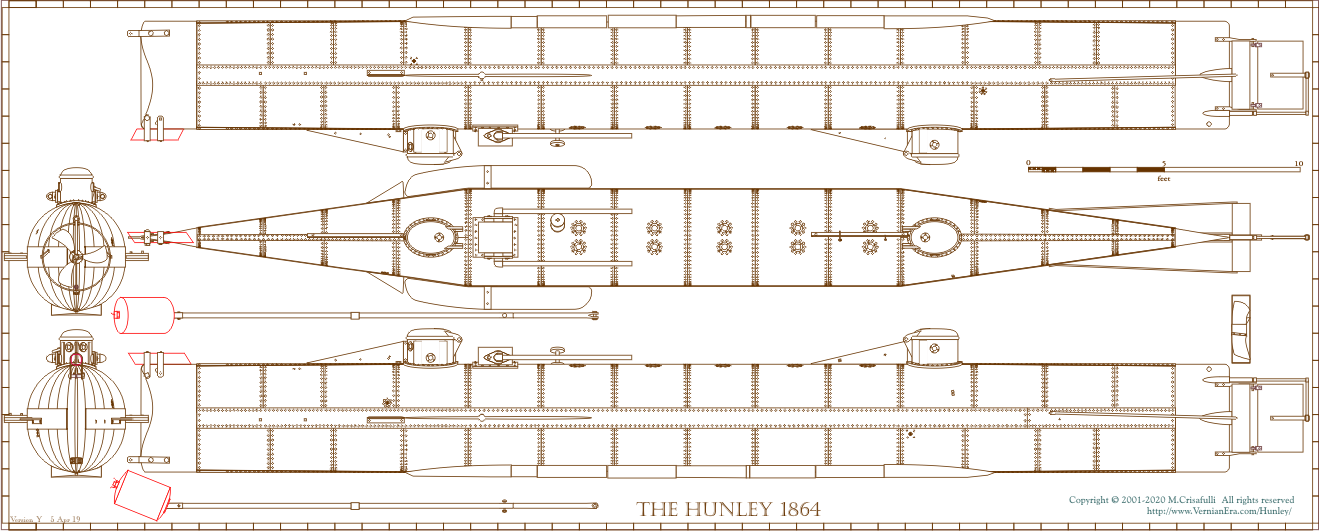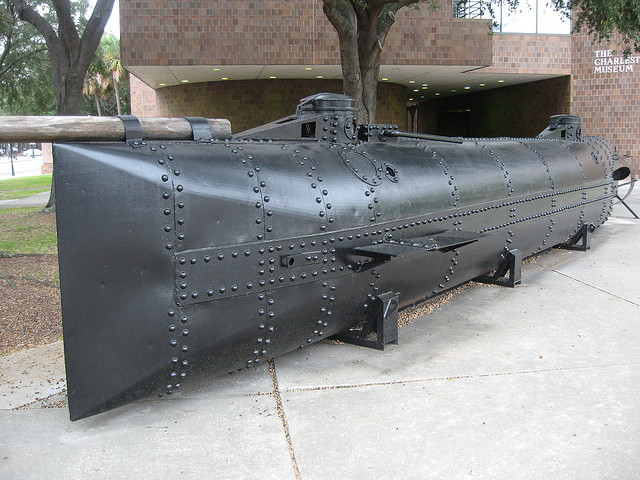
Most of Housatonic’s 155 crewmembers saved themselves by launching lifeboats or climbing the rigging, which remained above the harbor’s shallow 27-foot depth in time for rescue boats from a nearby Union warship to arrive. Housatonic took on water immediately, and within minutes it was a loss, the first warship to have ever been sunk by a submarine. The spar tore into Housatonic’s starboard quarter near its powder magazine, and the rebel torpedo laden with 135 pounds of gunpowder exploded. The captain and crew fired their rifles and shotguns in a futile attempt to halt the approaching vessel, but the bullets merely bounced off Hunley’s armor as a spar torpedo mounted at the end of a 16-foot rod that protruded from the submarine’s bow struck the warship. Beauregard had instructed Dixon to remain on the surface during any attacks, given Hunley’s previous accidents, most of the submarine still remained below the water line as it moved so close to Housatonic that the warship’s 12 cannons were useless. As Dixon led his men on the daring attack on Housatonic, he carried with him his good luck charm, a bent gold coin that had saved his life by slowing a bullet that wounded him two years before at the Battle of Shiloh.Īlthough Confederate P.G.T. Once again, the submarine was pulled to the surface, and even though he knew its tragic history, Lieutenant George Dixon agreed to take command of the vessel in November 1863 and raised a crew of courageous volunteers. The submarine was salvaged, but less than two months later, a second training accident killed the eight-member crew, including H.L. Shortly after testing began in Charleston Harbor, five of Hunley’s nine crewmembers drowned when a ship officer accidentally caused the vessel to dive while the hatches were still open. After successful tests on the Mobile River, the submarine was transported to Charleston in August 1863 amid hopes by the Confederate navy that it could be a secret weapon in breaking the Union blockade. It was constructed out of a 40-foot-long cylindrical iron steam boiler with a tapered bow and stern. Although Crosby initially thought he spotted a porpoise, the submarine more closely resembled a whale. The undersea vessel had been privately constructed in Mobile, Alabama, based on the plans of marine engineer Horace Lawson Hunley. Even if they hadn’t been bearing down on a mighty warship, the eight men were already undertaking a dangerous mission simply by being inside the submarine that had already claimed the lives of 13 men, including its inventor, during training exercises.

Hunley.Īs all hands raced to their stations on Housatonic, seven Confederate sailors inside the primitive submarine turned a handcrank that powered the propeller as another man steered toward the 1,240-ton sloop-of-war. Only four months before, USS New Ironsides had been partially damaged in an attack by the semi-submersible CSS David, and this windless, moonlit winter night offered perfect conditions for operating the approaching submarine, H.L.

But as the murky shadow rippled closer to the warship, the Navy officer sounded the alarm as he realized that the strange object closing in on Housatonic was actually a cutting-edge naval weapon-a submarine.īased on information gleaned from Confederate deserters, Union ships had been on alert for undersea vessels lurking in Charleston Harbor. At first, Crosby thought it could be a surfacing porpoise or perhaps a log. The moonlight shimmered on Charleston Harbor’s still surface as Housatonic patrolled the South Carolina waters as part of the Union naval blockade that was slowly strangling the Confederacy.Īs Crosby gazed out at the placid harbor around 8:45 p.m., Housatonic’s officer of the deck suddenly saw something shatter the water’s glassy surface only 100 yards away on the starboard side. On the clear but chilly night of February 17, 1864, John Crosby stood on the deck of USS Housatonic a little less than six miles and three years removed from the launching point of the Civil War, Fort Sumter.


 0 kommentar(er)
0 kommentar(er)
